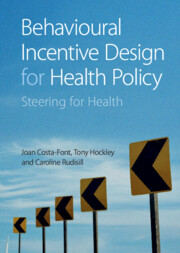Book contents
- Behavioural Incentive Design for Health Policy
- Behavioural Incentive Design for Health Policy
- Copyright page
- Contents
- Figures
- Preface
- Glossary
- 1 Behavioural Incentives and Health
- 2 Behavioural Learning and the Design of Incentives
- 3 Monetary Incentives for Health
- 4 Social Incentives for Health Behaviours
- 5 Nudging for Better Health
- 6 Social Preferences and Health
- 7 Behavioural Incentives for Health Behaviours
- 8 Behavioural Anomalies in the Demand for Health Care
- 9 Behavioural Anomalies in the Healthcare Supply
- 10 Behavioural Health Insurance Uptake
- 11 Ageing and Caregiving Decisions Over Time
- 12 Policy Applications from a Global Perspective
- References
- Index
5 - Nudging for Better Health
Published online by Cambridge University Press: 18 May 2023
- Behavioural Incentive Design for Health Policy
- Behavioural Incentive Design for Health Policy
- Copyright page
- Contents
- Figures
- Preface
- Glossary
- 1 Behavioural Incentives and Health
- 2 Behavioural Learning and the Design of Incentives
- 3 Monetary Incentives for Health
- 4 Social Incentives for Health Behaviours
- 5 Nudging for Better Health
- 6 Social Preferences and Health
- 7 Behavioural Incentives for Health Behaviours
- 8 Behavioural Anomalies in the Demand for Health Care
- 9 Behavioural Anomalies in the Healthcare Supply
- 10 Behavioural Health Insurance Uptake
- 11 Ageing and Caregiving Decisions Over Time
- 12 Policy Applications from a Global Perspective
- References
- Index
Summary
This chapter discusses the role of nudge interventions, which are interventions that modify the choice architecture without intervening in the actual choice set. We use nudges when we make subtle changes to the way choices are presented to individuals (the choice architecture). Such small changes are expected to encourage predictable behaviour and assist individuals in achieving goals that they desire. In general, it refers to interventions that, while preserving individuals' freedom of choice, steer them in a specific (socially desirable) direction, thereby improving welfare by assisting individuals in achieving welfare-improving goals (as judged by themselves). Individuals can continue to make whatever choices they want; they can always opt out of a default environment that steers them. Nudges preserve choice and can have a significant impact on our behaviour. They are appealing because they influence behaviour without using regulation or monetary incentives, and they are relatively inexpensive interventions. This chapter attempts to provide an overview of how to change the choice architecture by utilizing well-established cognitive biases discussed in this book.
Keywords
- Type
- Chapter
- Information
- Behavioural Incentive Design for Health PolicySteering for Health, pp. 75 - 88Publisher: Cambridge University PressPrint publication year: 2023

